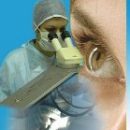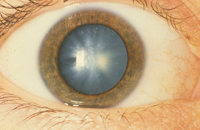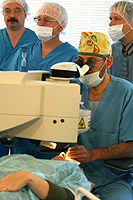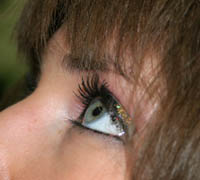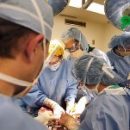Laser correction is the most popular way to correct myopia, hyperopia and astigmatism - the mass of articles and research is devoted, visitors to forums and blogs are discussed. But among adequate and truthful information, different kinds of speculation and judgments often slip, which frighten the inexperienced reader seeking truth.
Content
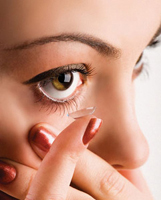
What you just do not know from the reports of friendly visitors of the network: and it is harmful, and it hurts, and during the correction they take a layer of the cornea, and they do not remove the problem, and you will have to walk for several months with a bandage in my eyes, and the laser correction can not be done by borrowed women, and Vision then falls again... Horror horror. I want to climb and exhale, say: «Not-her, I don't give my eyes to cut your eyes, it's better so much!»
Cut eyes! Where did it come from?! And who invented the horror stories about the bandages, the lack of statistics on laser corrections and other errors? It is difficult to answer this question, but in order to establish truth once and forever, turn to an irrefutable source: the history of the issue.
Radial keratotomy
So, the first method of correction of vision called «Radial keratotomy» appeared in the 30s. last century. The essence of him was that there were notches (from pupil to the periphery of the cornea), which were subsequently struck.
As a result, the shape of the cornea has changed and the vision has improved. However, these first survey operations were accompanied by many major complications (one of them is the clouding of the cornea leading to loss of vision).
The accuracy and stability of the result of such vision correction also left much to be desired, since the speed of healing depends on the individual cell regeneration rate for each person – Someone can boast that wounds he is healing instantly, and someone forces are forced to walk with a bandage because of the slightest scratch... Yes, and besides this, the toolkit of the surgeon was often distant from micron accuracy. It is this method that gave rise to many sense and prejudice, frightening people of the XXI century.
This method received a new life in the 70s, when it was improved by the famous ophthalmosorurg Svyatoslav Fedorov. By that time, new diamond instruments and microscopes have already appeared, which allowed to switch to the method of radial keratotomy to a qualitatively new level.
However, after surgery, there was still a long rehabilitation, complications often occurred, from the unspecified voltage with any load a patient could lose sight. Well, the question of the predictability of the result still remained open. Skeeping «Unit» managed to get a little. It is from here that the roots of many prejudices about laser correction. But attempts to find another way that allows you to return good vision, have not been left.
Laser vision correction
The history of the excimer laser actively used in modern ophthalmology begins in 1976. Then the attention of medical scientists attracted the development of IBM corporation. IBM specialists used a laser beam to apply engraving to the surface of computer chips. This procedure required a really jewelry accuracy (to microns), and know-how seriously interested doctors.
As a result of studies, doctors found that the safety of the use of a laser beam and the ability to control the exposure zone in depth and diameter is of particular importance in such a delicate area as refractive surgery. And the triumphal march of laser vision correction began.
In 1985, the first laser vision correction was carried out according to the FRK methodology. As well as during radial keratotomy, the impact was directly cornea. But the principle of impact was completely different. Applying notches was not required. The cornea shape changed under the influence of a laser, which evaporated the fabric from its surface and formed a new surface.
High accuracy allowed to achieve good predictability of the result, a significant reduction in the side effects of view correction. But for the patient, a period of restoration of the surface layer was extremely unpleasant (2-4 days), 3-4 weeks left for the fullest adaptation. But despite this, patients remained very satisfied, because the acquired excellent vision allowed very quickly to forget about the unpleasant sensations.
Lasik
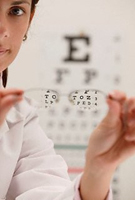
The most popular Methodology Lasik (Lasik) appeared in 1989. Its main advantage was the fact that the surface layers of the cornea were not affected, and the evaporation of the corneal tissue came from the middle layers. This method of laser correction has become a real revolution in refractive surgery, and today, LASIK allows vision correction under local anesthesia, in a few minutes, significantly reducing the rehabilitation period.
During correction using a special device - a microcratom - the surface layer of the cornea with a thickness of 130-150 microns is rejected, after which the laser evaporates part of the cornea and the separated flap of the cornea stacked in place. The recovery of the epithelium on the edge of the flap occurs within a few hours after the correction, and it is securely fixed. The patient immediately notes a significant improvement in view. Finally, its sharpness is restored for several days.
Lasik technology has passed a multi-step clinical trials before it began to be used in ophthalmological centers and clinics. Perennial observations of patients showed that the excimer laser does not cause any violations, since the impact occurs only on one of the refractive media – cornea, and the depth of exposure is strictly limited.
Today, this technique employs medical centers and clinics in 45 countries. Over the past 10 years, about 5 million vision corrections on the Lasik technique have been held in the world. In the United States and Japan, the procedure for recovering vision using laser correction has long been outside the specialized clinics. Often small laser correction centers can be seen in the territories of large shopping and entertainment complexes, near the dental and cosmetic cabinets and beauty salons.
The patient undergoes the diagnosis of view, and then, according to the data obtained during the examination, the doctor conducts correction. In addition, the US government as part of the national program of improving the Armed Forces year after year pays for laser correction of vision to military personnel of all ranks and childbirth.
Safety
The high level of security and the perfect laser installations of the last generation made a laser correction procedure simple and accessible to each. Of course, we must not forget that, like a medical method, laser correction has some contraindications and restrictions. It is not recommended for people suffering from HIV infection, tuberculosis, diabetes, some skin and eye diseases, pregnant women and nursing mothers, children under 18. But the same, to whom it is possible to restore vision with the help of this technology, the correction becomes a real salvation. After all, this is nothing comparable – every day to watch and see the world around the world bright and clear.
Among thousands of people who made a laser correction of vision, there is no one who would have regretted his decision to abandon the glasses and contact lenses. Former patients of ophthalmologists often admit that only after laser correction, they began to sense themselves with full-fledged people. It's so cool - not to take care of what you can not see something. Having made a correction, they persuade on this feat of all their badly seen familiar. And they, in turn, are more interested in why they were so poorly persuaded and could not convince.
The whole truth about laser feeding
The truth about the laser correction is that it really helps to get rid of myopia, hyperopia and astigmatism. To date, it is the most reliable and perfect way to restore vision, allowing you to forget about glasses and contact lenses once and for all!
In conclusion, I would like to note that it is still possible to trust the eyes and you only need specialized clinics in which experienced doctors in modern and gentle techniques work and using better equipment. After all, the experience of surgeons, modern equipment and techniques is the basis of the foundations of a high-quality ophthalmic clinic.

